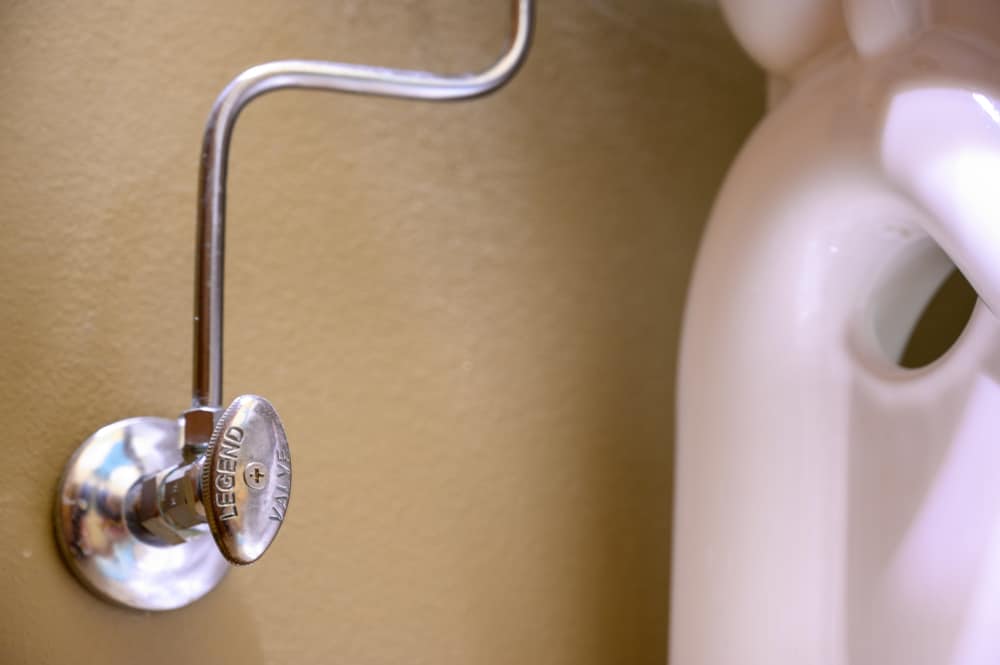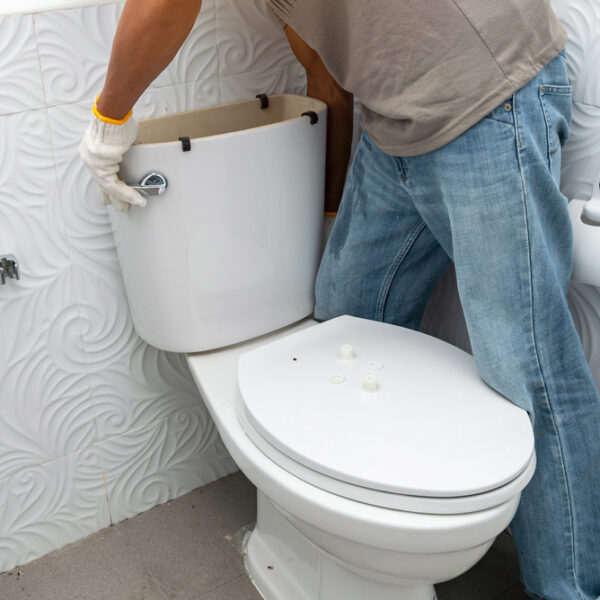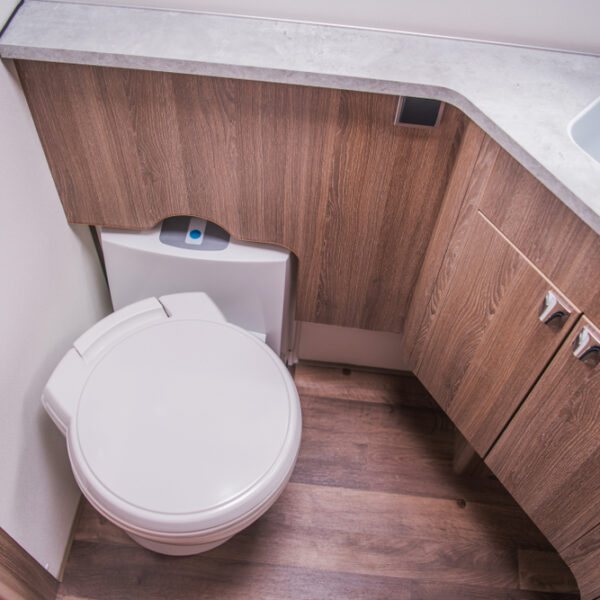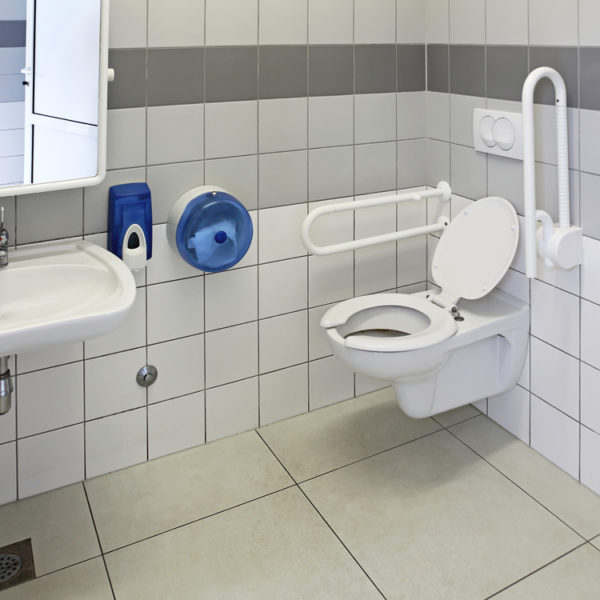Sometimes, you will need to replace the old shut-off valve to solve the problem of plumbing malfunctioning that occurs due to the pipeline blocking or clogging. In case of such an accident, the freshwater begins to overflow inside the toilet bowl until replacing the valve.
The first thing to solve before installing the new valve is determining the right toilet shut-off valve size. Even though you will probably need a valve of 3/8 inches (9.5 mm) in diameter, it is also possible to find those featuring other sizes. In some cases, you will need to ask a professional to determine the suitable model for your needs.
What Is a Toilet Shut-off Valve?
The toilet shut-off valve (stop valve) is a necessary part of the plumbing system typically installed behind the toilet bowl. Its primary roles are to control the water flow from the supply line to the tank and stop it from uncontrolled flowing.
This item has a significant role in the case of the toilet pipeline malfunctioning. That way, simple turning a valve clockwise from the current position will prevent damage in your home.
You can also turn it off when you want to go on vacation to stop the water flow for preventing reasons or when facing a toilet bowl clogging. Remember that an old or worn shut-off valve can’t fulfill its function, making regular maintenance and replacement crucial.
The first thing to check when controlling a stop valve is a rubber seal that becomes worn over time. Damaged seals can’t sufficiently hold the water flow to prevent damage from water spills.
In most cases, there is no need to replace the worn toilet shut-off valve as soon as you notice its malfunctioning. Sometimes, it will be enough to change a damaged rubber seal and fix the damage.
However, you should buy a new valve after a while and install it. The common reasons for this step are:
- Irregular water flow
- Water overflowing can’t stop after closing the shut-off valve
- When the shut-off valve gets stuck, and it is impossible to move it clockwise or in any other direction
In that case, it is crucial to find the proper toilet shut-off valve size since it needs to fit perfectly to the supply line hose. Otherwise, you can expect it to leak.
The Toilet Shut-off Valve Right Size
The rule of thumb is that the standard shut-off valve applicable to nearly all the supply lines is 3/8 inches (9.5 mm) in diameter. However, you can find three traditional toilet shut-off valve types on the market. Their standard diameters are 1/2, 1/4, and 3/8 inches (12.7, 6.35, and 9.5 mm).
According to their sizes, the supply line hoses are typically 1/2, 7/16, or 3/8 inches (12.7, 11, or 9.5 mm) in diameter. As you can guess, their standard size is usually 3/8 inches (9.5 mm).
Remember that proper pipeline functioning depends on the toilet shut-off valve type you choose since valves need to fit supply line hoses perfectly. Otherwise, you can have problems with water leakage.
Nowadays, it is possible to pick out any of the numerous toilet shut-off valve types available on the market. However, choosing one of 3/8 inches (9.5 mm) in diameter will make your life easier by ensuring adequate water flow inside the system.
The most common types in American households are:
- Sweat fitting stop valve
- Compression fit stop valve
- PEX stop valve
However, you can also find a few different models that are not widely used. Therefore, you should check your system before purchasing any of them, just in case.
Water Shut-Off Valves Types
Picking out a suitable toilet shut-off valve can be complicated for an inexperienced person since numerous types are available on the market. Plus, they come in various sizes, making a choice additionally complicated.
Therefore, you should learn to differentiate various types before going to the local plumbing shop. Other options are photographing the existing valve or removing and taking it to the shop for identification. Let’s check the list of the traditional stop valves available.
Toilet shut-off valve size |
|
| Toilet shut-off valve type | Size |
| Quarter-turn shut-off valve | 1/4 inches (6.35 mm) |
| Compression fit stop valve | 1/2 by 3/8 inches (12.7 x 9.5 mm)
5/8 by 3/8 inches (16 x 9.5 mm) |
| Sweat fitting stop valve | 3/4, 1/2, and 3/8 inches (19, 12.7, and 9.5 mm) |
| Push-fit stop valve | 3/8 inches (9.5 mm) |
| FIP threaded fitting shut off valve | 3/8 inches (9.5 mm) |
| Barbed fitting stop valve | 3/8 inches (9.5 mm) |
| Three-way shut-off valve | 3/8 inches (9.5 mm) |
| Plastic toilet shut-off valve | 3/8 inches (9.5 mm) |
| CPVC shut-off valve | 3/8 inches (9.5 mm) |
| PEX stop valve | 1/2 and 3/8 inches (12.7 and 9.5 mm) |
| Sweat fitting shut-off valve | 3/8 inches (9.5 mm) |
Compression fit stop valve
Compression fit shut-off valves are the maintenance-free option for PEX pipes and copper-based ones that provide high compression power. They are available in two variants:
- Quarter turn compression valve type
- Multi-turn compression valve type
While a multi-turn compression valve type is more affordable, quarter-turn valves are high-quality and more reliable. Before buying one, you should check which one of two size options is suitable for your toilet:
- 1/2 by 3/8 inches (12.7 x 9.5 mm)
- 5/8 by 3/8 inches (16 x 9.5 mm)
You can install both types without professional help but be prepared that the installation process requires special tools.
Sweat fitting shut-off valve
You can install a cost-effective sweat fitting shut-off valve only if you have a copper fluid supply line. You can find them in a few sizes, including:
- 3/4 inches (19 mm)
- 1/2 inches (12.7 mm)
- 3/8 inches (9.5 mm)
This valve type’s advantages are affordability, durability, and long lifespan. The problem is that they are permanent and can be challenging to remove when needed. Its installation requires some skills since you should solder it onto a copper pipe. Plus, you need specific tools for this task, such as:
- Copper tube cutter
- Propane torch
- Solder
- Emery cloth sandpaper
- Flux
In this case, a better option is to hire a professional to finish the required job precisely.
PEX stop valve
Inexpensive PEX shut-off valves are made of cross-linked polyethylene and designed for pipes with clamp rings. You can typically find them in two standard sizes:
- 1/2 inches (12.7 mm)
- 3/8 inches (9.5 mm)
Another thing to check is which model you need for your toilet:
PEX clamp shut-off valve – This model has ribbed fittings that fit PEX plastic pipes. Their installation requires pressing the crimp ring against the pipe’s outer side with ring compression equipment.
PEX push-fit shut-off valve – It is a better option since it comes without an external clamp, making DIY installation effortless. It will be enough to push it onto the pipe to lock it into position. This valve type fits PEX, CPVC, copper, plastic, and many other pipe types.
Other toilet shut-off valve types
Other less common toilet stop valves you can find on the market include:
- Quarter turn and multi-turn water stop valves
- Push-fit/push-on stop valve
- Female iron pipe
- Barbed fitting stop valve
- Three-way shut off valve
- CPVC shut-off valve
Toilet Shut-Off Valve Operation and Configuration
Toilet shut-off valves’ purpose is to stop the water overflow. You can classify them by a few features:
By the inlet and outlet diameter and the way they operate
You can recognize multi-turn stop valves and quarter-turn stop valves.
By configuration
It is possible to find straight stop valves with aligned inlet and outlet and angle valves with the outlet and supply line placed at a 90-degree to each other.
By connections
Not all shut-off valve fits every supply line, but it depends on the connecting pipe material.
- PEX supply lines require barbed, push-to-connect, or compression fitting shut-off valve
- Copper supply lines go with sweat, compression, or push-to-connect fitting stop valve
- Galvanized steel pipes need female iron pipe connections
- CPVC supply lines use fitting stop valves with push-to-connect or threaded connections
By material
Most manufacturers use standard materials to make toilet shut-off valves. The most common option is brass because of this metal’s reliability, durability, and long lifespan. Another option is polypropylene or plastic, suitable options when the expected pressure is not too high.
By locations
The best places to install a toilet shut-off valve are underneath and behind a toilet bowl, depending on your bathroom configuration.
Water Pipe Types
Besides choosing the best toilet shut-off valve type for your home, you should consider adequate water supply lines. They come in several options, and you should be careful when installing them since not all valves fit each particular pipe type. The most common are:
- Recyclable copper pipes are the most popular in the US
- Durable galvanized steel or iron pipes
- Inexpensive CPVC (chlorinated polyvinyl chloride) pipes
- DIY-friendly PEX pipes
- Lightweight and easy to install PVC pipes
Summary
Whether installing or replacing an old shut-off valve, the question is which size you need. It can be challenging to guess such information, so you should check the old valve measurement before purchasing the new one.
In most cases, you can find three standard sizes, so you only need to find the right one to prevent possible issues resulting from a wrong assessment.








